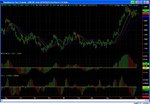jessechan said:
I would like to buy one of Bill Williams's books, which one should I read first?
Thanks.
Jesse
I would suggest the following reading plan.
First, read "Trading Dimensions", it is the most accessible book, but do not attempt to trade using only those techniques.
Second, read Frost and Prechter's "The Elliot Wave Principle" if you have no Elliott wave background. It is necessary if you are to fully comprehend his method. It will serve as background for the following reading.
Third, read the
first edition of "Trading Chaos". It is complete different than the second edition. It not as accessible as the "Trading Dimensions". It assumes you understand Elliott wave concepts. My interpretation of his use of Elliott wave is not as a trading entry or trigger but as a filter to keep from trying to trade choppy, corrections such as wave 4. He suggests that if you want to trade corrections that you need to drill down to a lower time frame, usually intraday, so that you catch small impulsive waves.
Fourth, you can then read the second edition of "Trading Chaos" which introduces some counter trend techniques, which make more sense in the context of Elliott wave concepts. But again Elliott wave ideas are not used as triggers or entries but as filters to eliminate or reduce loss creating market action or as a hint to drill down to lower time frames to find trades.
Finally, you need to develop and test a trading plan that defines the mechanical and discretionary aspects. If you try to trade this in a complete mechanical manner, you will lose money. And, after reading the first book in the above reading plan, "Trading Dimensions", it will be tempting to trade the setups mechanically.
Do not let the "flowery" language in the both the trading psychology and methodology sections put you off. Do not let the unusual language or references to chaos put you off. I found that there was a lot of wisdom to be extracted but that it took significant time and working with the ideas.




